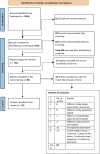Effectiveness of smartphone technology for detection of paediatric ocular diseases-a systematic review
- PMID: 40448047
- PMCID: PMC12123870
- DOI: 10.1186/s12886-025-04160-2
Effectiveness of smartphone technology for detection of paediatric ocular diseases-a systematic review
Abstract
Background: Artificial intelligence has become part of healthcare with a multitude of applications being customized to roles required in clinical practice. There has been an expanding growth and development of computer technology with increasing appearance in the ophthalmological universe with roles in detection of most ophthalmic diseases. This article attempts to study the efficacy of smartphones and their applications in detection of paediatric eye diseases.
Methods: On 24 January 2024, a comprehensive search was performed across five databases-PubMed, Scopus, Web of Science, Cumulative Index to Nursing and Allied Health Literature, and ProQuest-focusing on studies assessing smartphone-based disease detection and diagnostic accuracy compared to validated methods. Keywords and MeSH terms, including "smartphone," "eye diseases," and "children," were combined using Boolean operators and eligible studies were obtained. The inclusion criteria covered studies from 2000 to 2023, involving children under 18 years, and reporting diagnostic outcomes. Exclusions included studies not exclusive to eye disease, purely adult population studies, reviews, studies with non-availability of full text, and studies exploring other uses of smartphone and designs lacking diagnostic efficacy analysis. Article quality was assessed using the Joanna Briggs Institute Critical Appraisal Checklist.
Results: A total of 2054 articles were retrieved. After removing 1112 duplicates, 507 records were excluded through title screening, followed by 333 through abstract screening. A full-text review of 83 articles led to the inclusion of 33 studies, involving 16,015 participants. Most of the studies (28, 84.84%) were of high quality, with five (15.15%) of moderate quality. Twelve smartphone applications assessed refractive errors using visual acuity tests or photorefraction, five detected amblyogenic risk factors, six identified strabismus, and three targeted leukocoria. Additional applications evaluated stereoacuity (two), eyelid position (one), chalazion (one), corneal diameter (one), and retinopathy of prematurity (two). Overall, these applications demonstrated the potential of smartphones in paediatric eye disease detection.
Conclusion: Smartphone applications are effective tools for detecting important causes of childhood eye disorders such as strabismus, retinopathy of prematurity, chalazion, and refractive errors. These technologies offer promising opportunities for teleophthalmology and integration into routine clinical practice.
Keywords: Child; Eye diseases; Mobile applications; Paediatric; Smartphone; Visual disorders.
© 2025. The Author(s).
Conflict of interest statement
Declarations. Ethics approval and consent to participate: Not applicable as this was a systematic review of already available literature on public databases. Consent for publication: Not applicable as human subjects not involved. Competing interests: The authors declare no competing interests.
Figures
References
-
- Application of Artificial Intelligence-Based Technologies in the Healthcare Industry: Opportunities and Challenges - PubMed, https://pubmed.ncbi.nlm.nih.gov/33401373/ (accessed 10 May 2024). - PMC - PubMed
-
- Tenório Albuquerque Madruga Mesquita MJ, Azevedo Valente TL, de Almeida JDS, et al. A mhealth application for automated detection and diagnosis of strabismus. Int J Med Inf. 2021;153:104527. - PubMed
Publication types
MeSH terms
LinkOut - more resources
Full Text Sources
Medical


